This year’s spring holiday was extra special—it was our first as a family! We couldn’t resist the chance to hop on EasyJet’s new direct flight from London to Santorini and explore this ridiculously photogenic island. It was also Chiara’s first trip outside of France, and she was warmly welcomed. The weather started off hot and sunny, but we got two days of strong wind to keep things interesting!
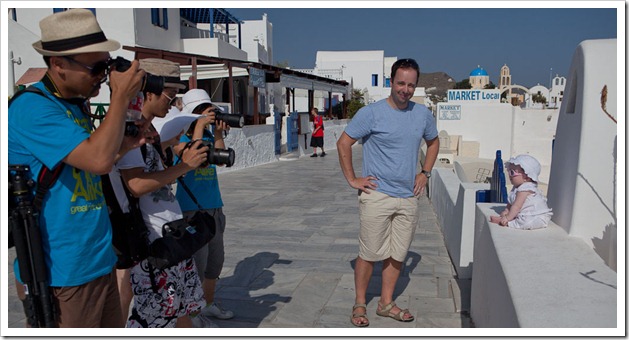
Canon EOS 5D Mk II – 1/1000 sec at f/5, ISO 100 – Chiara was a good attraction from everyone. In particular when we dressed her in white or blue (local colours), she was a photographers attraction. Not as much success as little Buddha, but close. She did not seem to mind paparazzi and was smiling to everyone around.
We didn’t get to do as much as we’d originally planned—no long walk from Fira to Oia, and no visit to the volcano. Most of our days were spent in our “luxury cave,” especially during the hotter hours for siestas and cooling off. We did rent a car for a day to explore some smaller villages and beaches, and I managed an early morning visit to Fira. But for the most part, we stayed in Oia, hands down the prettiest village on the island.
To get Chiara around, we relied on the baby backpack carrier. Our Deuter Kid Comfort III is rated for up to 22kg, but with just 7kg of Chiara, the heat and Oia’s endless stairs made it plenty of a workout. We also found it super handy for evening dinners—Chiara would often fall asleep in it while we enjoyed our meals. Definitely a lifesaver!
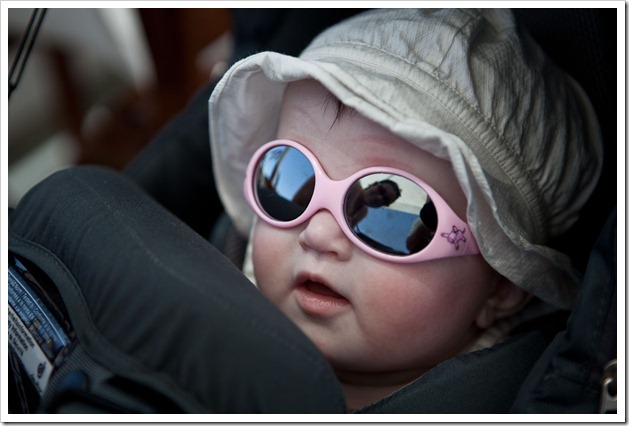
Canon EOS 5D Mk II – 1/120 sec at f/2.8, ISO 100 – Chiara in her backpack, all ready with hat, sun canopy, sun cream level 50 and sunglasses Cat 4. She usually felt asleep after 15mins of walk with the movement of the walk – to later wake up with red marks on her face …
Where are the best spots of the Island ?
I’ve never seen so many DSLRs, tripods, and photographers packed into one place as I did in Oia. They were everywhere! Unsurprisingly, the best photo ops were at sunrise and sunset, though the bright midday sun also offered some unique shots. With the strong light bouncing off the white houses (a bit like snow), the camera had a tendency to underexpose—something to keep in mind for those dreamy Santorini captures!
![20100618_SAN_208[12]](http://www.vgway.com/wp-content/uploads/20100618_SAN_20812_thumb.jpg)
Canon EOS 5D Mk II – 1/1600 sec at f/5, ISO 100 – Typical Santorini colours, blue and white paint, dark blue sky and sometimes some very bright orange or red paint. This picture was taken in Oia off the main street with at 17mm from the ground so the perspective looks a bit funny but the full panel is there.
Sunset, on the other hand, is a completely different story. It’s when the crowds descend—tourists from big cruise ships or other parts of the island flock to Oia because the sunsets here are so famous. Most people gather in front of the sun with a view of the two abandoned windmills (see picture below). Personally, I don’t find it very romantic (hundreds of people crammed together) or ideal for photography. Shooting directly into the sun isn’t great, and there’s no interesting foreground to work with. Add to that the fact that you need some clouds to really bring out the colors, and I still don’t get why so many tripods were lined up there three hours ahead of time every single day!
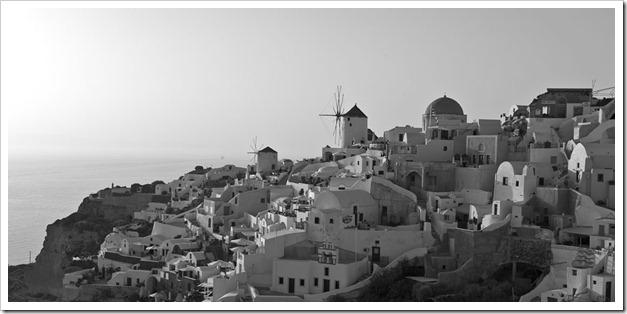
Canon EOS 5D Mk II – 1/50 sec at f/10, ISO 320 (mid) – View of Oia from the famous “sunset spot”. The image was cropped to panoramic format, des-saturated and multiple exposure were merged to get more dynamic ranges (the sky is very bright and the houses in the shadow at the time of the day)
The promise of HDR
This time, we decided to dive into High Dynamic Range (HDR) photography a bit more seriously. The concept is pretty simple: you take multiple shots at different exposures and merge them on the computer, usually giving more weight to the mid-tones. The tricky part is figuring out which scenes actually work best with this technique—it can look super natural or completely overdone, depending on the approach.
Santorini seemed like a great place to try HDR, with its mix of super bright areas (white houses, blue sky) and darker ones (the sea, doors, and shadows). But we quickly learned that HDR isn’t a magic fix for exposure issues in scenes like this. In the end, our results weren’t quite as impressive as we’d hoped. Still, it was a good experiment!
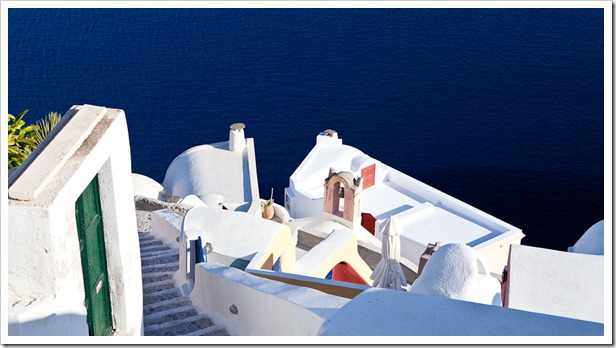
Canon EOS 5D Mk II – 1/250 sec at f/7.1, ISO 100 – This picture was taken at 40mm, a plunging view on the caldera. It was taken late afternoon and due to the bright white houses, the sea appeared black on the RAW file, so I had to boost saturation a bit so see a bit a blue. Picture was finally cropped to give a more dynamic, panoramic look.
Most of our HDR attempts were done at sunset, often shooting directly at the sun. It’s tough to capture colors effectively in those conditions, so the HDR results didn’t turn out much better than simply adjusting highlights and shadows from a single shot.
So, we decided to shift our focus and concentrate on creating some panoramas instead…
Why does Santorini look better in panoramic ?
The panoramic format is perfect for landscapes, and Santorini is no exception. What makes it even more unique is the way the scenery naturally spreads out horizontally—you’ve got houses and churches, the Caldera, and a mix of foreground and background elements, all lined up. The view often feels like it spans 180 degrees, making it almost impossible not to think in panoramas.
Another challenge is the lighting. There’s often a strong contrast between shadows at the bottom and bright highlights at the top. With a typical shot containing about a third sky, it’s hard to get the exposure just right. We often ended up cropping out the bottom to create a panoramic view that better captured the scene.
And let’s be honest, there’s probably a psychological element too. Santorini is so famous for its panoramic views—we’ve all seen countless postcards and pictures in this format—it’s hard not to be influenced!
To create our panoramas, we used two main techniques. One was cropping a single wide-angle shot (we used a 17-40mm f/4 L lens for this). The other was stitching together multiple exposures to build a full panorama. Both approaches gave us some stunning results!
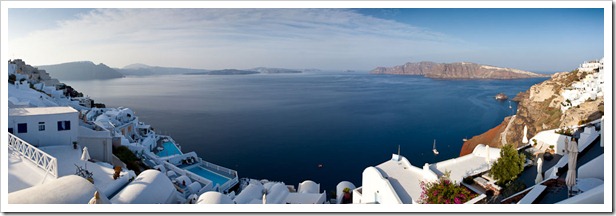
Canon EOS 5D Mk II – 1/2500 sec at f/3.5, ISO 200 – View of the Caldera directly from our private terrace, early morning. This shoot is a merge of 3 pictures taken with rotation of the camera (no tripod). The final image is 12K pixels long.
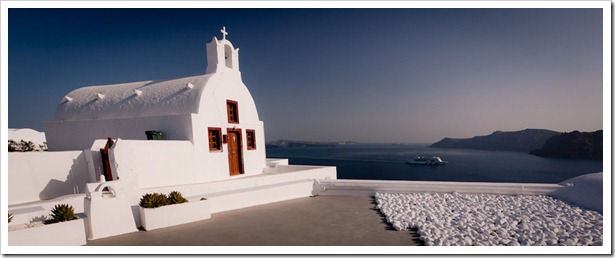
Canon EOS 5D Mk II – 1/30 sec at f/20, ISO 100 – This picture was taken at 17mm, with some perspective corrected in lightroom then cropped to give a panoramic format. It was taken late afternoon, a slight darkening filter was applied to the sky to give it a more dramatic look.
Missing a fisheye? Absolutely. A high-quality fisheye lens would have been perfect for this trip. Most of our true 180-degree panoramic shots were taken at around 20mm with our 17-40mm f/4 L lens, which meant we had to stitch together 3 or 4 images to capture the full view. It worked, but a fisheye would’ve made things so much easier. Next time, for sure!
Comments 3
Amazing shots man … we will be planning a trip there for sure 🙂
magnifique!!!
looking for tickets to go to santorini already… chiara needs to start charging for photos .. then you guys can stop working 🙂